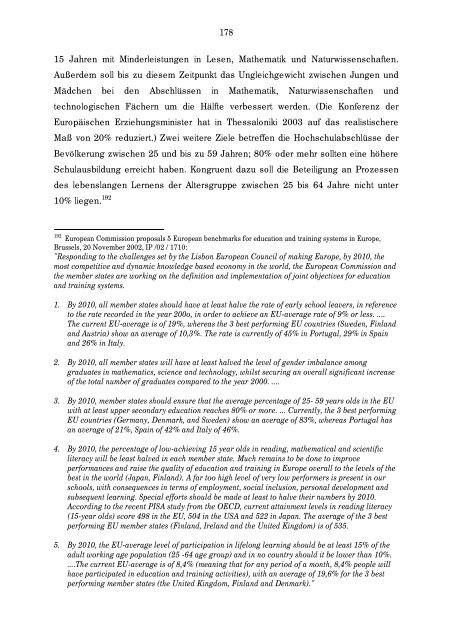Entwicklung und Perspektiven der Schulaufsicht - KOBRA ...
Entwicklung und Perspektiven der Schulaufsicht - KOBRA ...
Entwicklung und Perspektiven der Schulaufsicht - KOBRA ...
Sie wollen auch ein ePaper? Erhöhen Sie die Reichweite Ihrer Titel.
YUMPU macht aus Druck-PDFs automatisch weboptimierte ePaper, die Google liebt.
178<br />
15 Jahren mit Min<strong>der</strong>leistungen in Lesen, Mathematik <strong>und</strong> Naturwissenschaften.<br />
Außerdem soll bis zu diesem Zeitpunkt das Ungleichgewicht zwischen Jungen <strong>und</strong><br />
Mädchen bei den Abschlüssen in Mathematik, Naturwissenschaften <strong>und</strong><br />
technologischen Fächern um die Hälfte verbessert werden. (Die Konferenz <strong>der</strong><br />
Europäischen Erziehungsminister hat in Thessaloniki 2003 auf das realistischere<br />
Maß von 20% reduziert.) Zwei weitere Ziele betreffen die Hochschulabschlüsse <strong>der</strong><br />
Bevölkerung zwischen 25 <strong>und</strong> bis zu 59 Jahren; 80% o<strong>der</strong> mehr sollten eine höhere<br />
Schulausbildung erreicht haben. Kongruent dazu soll die Beteiligung an Prozessen<br />
des lebenslangen Lernens <strong>der</strong> Altersgruppe zwischen 25 bis 64 Jahre nicht unter<br />
10% liegen. 192<br />
192<br />
European Commission proposals 5 European benchmarks for education and training systems in Europe,<br />
Brussels, 20 November 2002, IP /02 / 1710:<br />
"Responding to the challenges set by the Lisbon European Council of making Europe, by 2010, the<br />
most competitive and dynamic knowledge based economy in the world, the European Commission and<br />
the member states are working on the definition and implementation of joint objectives for education<br />
and training systems.<br />
1. By 2010, all member states should have at least halve the rate of early school leavers, in reference<br />
to the rate recorded in the year 200o, in or<strong>der</strong> to achieve an EU-average rate of 9% or less. ....<br />
The current EU-average is of 19%, whereas the 3 best performing EU countries (Sweden, Finland<br />
and Austria) show an average of 10,3%. The rate is currently of 45% in Portugal, 29% in Spain<br />
and 26% in Italy.<br />
2. By 2010, all member states will have at least halved the level of gen<strong>der</strong> imbalance among<br />
graduates in mathematics, science and technology, whilst securing an overall significant increase<br />
of the total number of graduates compared to the year 2000. ....<br />
3. By 2010, member states should ensure that the average percentage of 25- 59 years olds in the EU<br />
with at least upper secondary education reaches 80% or more. ... Currently, the 3 best performing<br />
EU countries (Germany, Denmark, and Sweden) show an average of 83%, whereas Portugal has<br />
an average of 21%, Spain of 42% and Italy of 46%.<br />
4. By 2010, the percentage of low-achieving 15 year olds in reading, mathematical and scientific<br />
literacy will be least halved in each member state. Much remains to be done to improve<br />
performances and raise the quality of education and training in Europe overall to the levels of the<br />
best in the world (Japan, Finland). A far too high level of very low performers is present in our<br />
schools, with consequences in terms of employment, social inclusion, personal development and<br />
subsequent learning. Special efforts should be made at least to halve their numbers by 2010.<br />
According to the recent PISA study from the OECD, current attainment levels in reading literacy<br />
(15-year olds) score 498 in the EU, 504 in the USA and 522 in Japan. The average of the 3 best<br />
performing EU member states (Finland, Ireland and the United Kingdom) is of 535.<br />
5. By 2010, the EU-average level of participation in lifelong learning should be at least 15% of the<br />
adult working age population (25 -64 age group) and in no country should it be lower than 10%.<br />
....The current EU-average is of 8,4% (meaning that for any period of a month, 8,4% people will<br />
have participated in education and training activities), with an average of 19,6% for the 3 best<br />
performing member states (the United Kingdom, Finland and Denmark)."
















